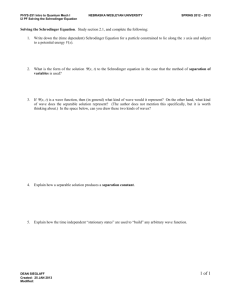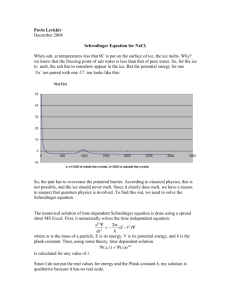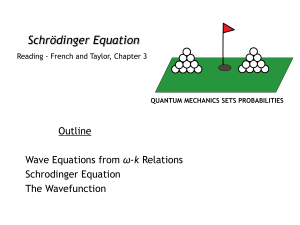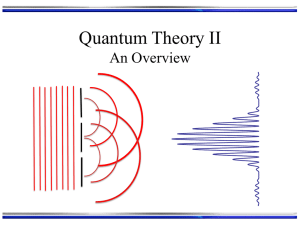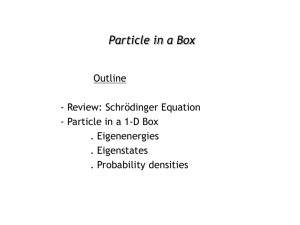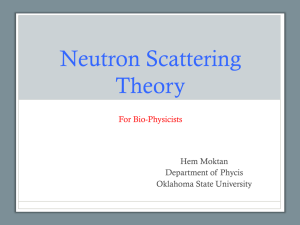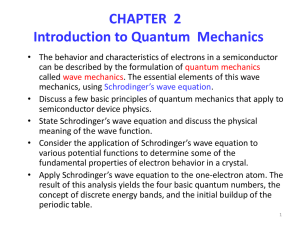TermPaper - UT Relativity Group
advertisement
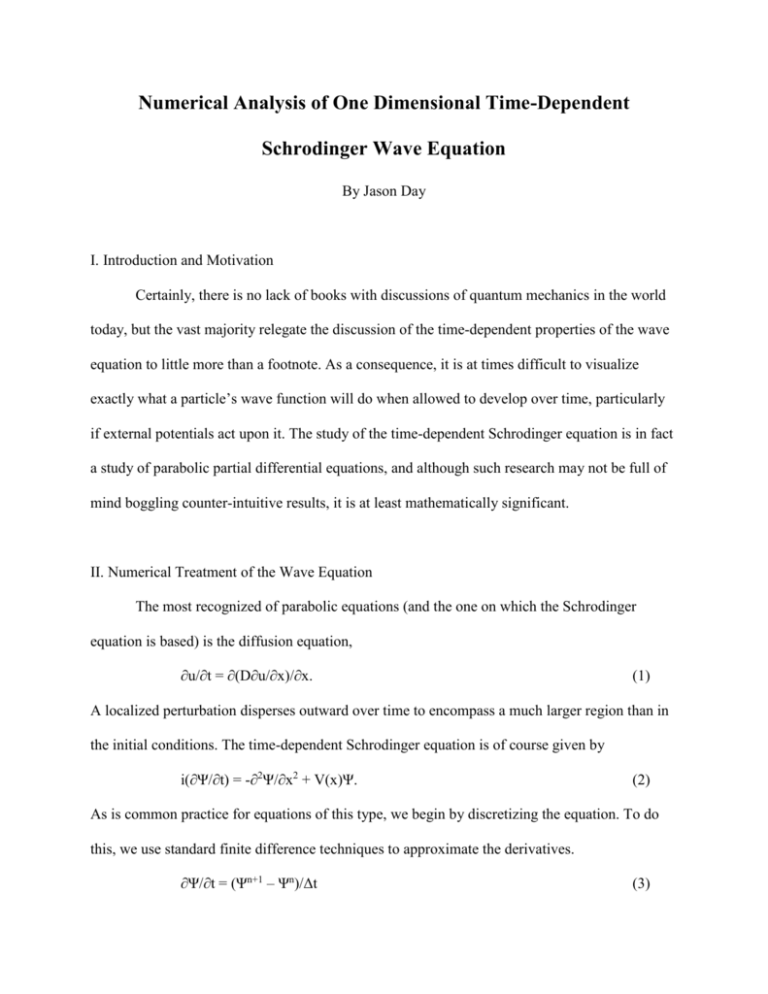
Numerical Analysis of One Dimensional Time-Dependent Schrodinger Wave Equation By Jason Day I. Introduction and Motivation Certainly, there is no lack of books with discussions of quantum mechanics in the world today, but the vast majority relegate the discussion of the time-dependent properties of the wave equation to little more than a footnote. As a consequence, it is at times difficult to visualize exactly what a particle’s wave function will do when allowed to develop over time, particularly if external potentials act upon it. The study of the time-dependent Schrodinger equation is in fact a study of parabolic partial differential equations, and although such research may not be full of mind boggling counter-intuitive results, it is at least mathematically significant. II. Numerical Treatment of the Wave Equation The most recognized of parabolic equations (and the one on which the Schrodinger equation is based) is the diffusion equation, ∂u/∂t = ∂(D∂u/∂x)/∂x. (1) A localized perturbation disperses outward over time to encompass a much larger region than in the initial conditions. The time-dependent Schrodinger equation is of course given by i(∂Ψ/∂t) = -∂2Ψ/∂x2 + V(x)Ψ. (2) As is common practice for equations of this type, we begin by discretizing the equation. To do this, we use standard finite difference techniques to approximate the derivatives. ∂Ψ/∂t = (Ψn+1 – Ψn)/Δt (3) ∂2Ψ/∂x2 = (Ψj+1 – 2Ψj + Ψj-1)/Δx2 (4) Now, ordinarily, a Forward Time Center Space (FTCS) method would be used to get the future time step, n+1. This method uses the two approximations above and solves for Ψn+1 (the Ψ terms of equation (4) are understood to have time indices of Ψn) in equation (2). The FTCS method provides a perfectly viable solution to the Schrodinger equation, but we have not yet considered the circumstances under which this solution remains well behaved. For this we turn to stability analysis; the amplification factor for the FTCS method is ξ = 1 – (4Δt/Δx2)sin2(kΔx/2). (5) Also from stability analysis, we know that this amplification factor must obey the relation, |ξ| ≤ 1 (6) which leads to the following condition for stability: Δt/Δx ≤ Δx/2. (7) This suggests that the temporal mesh spacing must be much smaller than the spatial mesh spacing. As this is a very onerous burden on the calculation, we ought to look for a more universally stable way to come about a solution. Another finite differencing scheme, called the Fully Implicit method, uses a different approximation in place of equation (4), ∂2Ψ/∂x2 = (Ψj+1n+1 – 2Ψjn+1 + Ψj-1n+1)/Δx2. (8) Notice that the only difference between this method and the FTCS method is that equation (8) is evaluated at the advanced time step, n+1. The drawback to using this method is that it is only first order accurate in time. However, the stability analysis produces very desirable results. The amplification factor for the fully implicit method is ξ = 1/[1 + (4Δt/Δx2)sin2(kΔx/2)]. (9) Obviously, equation (9) will be between 1 and –1 for any size of Δt. Thus, the amplification factor always satisfies equation (6) and the scheme is stable unconditionally. How can we then combine the accuracy of the FTCS method with the stability of the fully implicit method? The answer is actually quite simple – just use both of them! This differencing scheme is known as the Crank-Nicholson scheme. We can write the second partial derivative of Ψ as an average of both of the approximations... ∂2Ψ/∂x2 = [(Ψj+1n+1 – 2Ψjn+1 + Ψj-1n+1) + (Ψj+1n – 2Ψjn + Ψj-1n)]/2Δx2 . (10) This equation is indeed second order accurate in time; the amplification factor is given by ξ = [1 – (2Δt/Δx2)sin2(kΔx/2)]/[1 + (2Δt/Δx2)sin2(kΔx/2)]. (11) Again, this equation satisfies the condition |ξ| ≤ 1 for any stepsize of Δt. III. Implementation Notes See the source code for the programs themselves for specific details on the implementation of the Crank-Nicholson differencing scheme. After the scheme has been used to discretize the Schrodinger equation, the equation must be solved for Ψn+1. Of course, the Ψn+1 terms are the only unknowns in the equation. The equation is then of the form AΨn+1 = b (12) where A is a tri-diagonal matrix (consisting of the j+1, j, and j-1 coefficients of Ψn+1) and b is a column vector containing the known values of Ψn for each spatial step, j. Since complex terms are used in the equation, we must use the LAPACK solver ZGTSV to solve the system of nx equations for Ψn+1(xj), j = 1 to nx. We then have only to supply the initial conditions and boundary values in order to make the algorithm work. The initial conditions are really just any arbitrary waveform. For increased physical significance we will consider a particle that has just undergone a measurement. That is, the position is known to a high degree of accuracy and the probability distribution function |Ψ*Ψ| has been collapsed down to a single spatial interval (in between x and x + Δx). This lets us observe the time scale required for the wave function to expand out sufficiently that its distribution function does not change much with each interval Δt. As for the boundary conditions, we require that Ψ → 0 as x → ±∞. For the purposes of this program, we can collapse the real number line onto the interval [0, 1]. Then our boundary conditions are simply the Dirichlet boundary conditions, Ψ( 0, t) = 0 (13) Ψ( 1, t) = 0. (14) Only one other concern remains: that the wave function remain normalized over all time steps. The normalization condition for the Schrodinger wave equation is ∫Ψ*Ψdx = 1. (15) This basically says that the area under the curve of the probability distribution function is equal to unity. Also, the Schrodinger equation is such that, once normalized, it will always remain so. Therefore, we have only to normalize the initial conditions to satisfy equation (15) for all time steps. This can be done by ensuring that the xj that originally contains the particle has a magnitude of Ψ given by, Ψ(xj) = √(1/dx). (16) The programs designed for this project are all very similar. The only difference between them is the shape of the potential function. Again see the comments in the programs for notes on how the potential factors into the calculation. Notice that my Makefile includes options make freeplot, make stepplot, and make wellplot that execute their respective programs with parameters defined in Makefile and then automatically produce surface plots from gnuplot. The specified parameters for each program are: level - # of spatial steps = 2**level + 1 courant – the courant number, ratio of Δx/Δt olevel – output level IV. Conclusions As I mentioned before, nothing substantially exciting. As time progresses, the particle has a higher probability of being found farther and farther out from its original position. However, it is still at rest, so many interesting phenomena associated with quantum mechanics cannot be observed. I was able to successfully shift the particle over a good bit from its initial position in graph 2 by making the potential on the step function very steep (V0 ~ 100). At any rate, this was a successful attempt at modeling a physical system and though it may only be modest, everyone has got to start somewhere.
